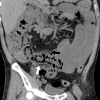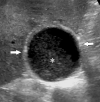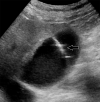Abdominal Imaging Findings in COVID-19: Preliminary Observations
- PMID: 32391742
- PMCID: PMC7508000
- DOI: 10.1148/radiol.2020201908
Abdominal Imaging Findings in COVID-19: Preliminary Observations
Abstract
Background Angiotensin-converting enzyme 2, a target of severe acute respiratory syndrome coronavirus 2 (SARS-CoV-2), demonstrates its highest surface expression in the lung, small bowel, and vasculature, suggesting abdominal viscera may be susceptible to injury. Purpose To report abdominal imaging findings in patients with coronavirus disease 2019. Materials and Methods In this retrospective cross-sectional study, patients consecutively admitted to a single quaternary care center from March 27 to April 10, 2020, who tested positive for SARS-CoV-2 were included. Abdominal imaging studies performed in these patients were reviewed, and salient findings were recorded. Medical records were reviewed for clinical data. Univariable analysis and logistic regression were performed. Results A total of 412 patients (average age, 57 years; range, 18 to >90 years; 241 men, 171 women) were evaluated. A total of 224 abdominal imaging studies were performed (radiography, n = 137; US, n = 44; CT, n = 42; MRI, n = 1) in 134 patients (33%). Abdominal imaging was associated with age (odds ratio [OR], 1.03 per year of increase; P = .001) and intensive care unit (ICU) admission (OR, 17.3; P < .001). Bowel-wall abnormalities were seen on 31% of CT images (13 of 42) and were associated with ICU admission (OR, 15.5; P = .01). Bowel findings included pneumatosis or portal venous gas, seen on 20% of CT images obtained in patients in the ICU (four of 20). Surgical correlation (n = 4) revealed unusual yellow discoloration of the bowel (n = 3) and bowel infarction (n = 2). Pathologic findings revealed ischemic enteritis with patchy necrosis and fibrin thrombi in arterioles (n = 2). Right upper quadrant US examinations were mostly performed because of liver laboratory findings (87%, 32 of 37), and 54% (20 of 37) revealed a dilated sludge-filled gallbladder, suggestive of bile stasis. Patients with a cholecystostomy tube placed (n = 4) had negative bacterial cultures. Conclusion Bowel abnormalities and gallbladder bile stasis were common findings on abdominal images of patients with coronavirus disease 2019. Patients who underwent laparotomy often had ischemia, possibly due to small-vessel thrombosis. © RSNA, 2020.
Figures















References
-
- Cheung KS, Hung IF, Chan PP, et al. Gastrointestinal manifestations of SARS-CoV-2 infection and virus load in fecal samples from the Hong Kong cohort and systematic review and meta-analysis. Gastroenterology doi:10.1053/j.gastro.2020.03.065. Published online April 3, 2020. Accessed April 17, 2020. - PMC - PubMed
MeSH terms
LinkOut - more resources
Full Text Sources
Miscellaneous

